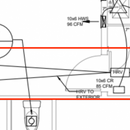Reasonable HRV configuration?
Hello, I received the design for an HRV system in a gut renovation. It appears as if the HRV has only one supply and one return vent, and they’re very close to each other. The contractor who designed the system said he prefers not to have supply vents in individual rooms because of the potential for pressurization. This doesn’t seem to be in line with the research I’ve done on HRV/ERV configuration, though. I’ve attached a diagram of the design. Does this seem like a reasonable configuration? Thanks!
GBA Detail Library
A collection of one thousand construction details organized by climate and house part










Replies
Unless you have a very small house with few rooms, that is not reasonable. His explanation doesn't make a lot of sense either.
It's not a huge house, but also never very small. I'm no expert, but his explanation didn't make a whole lot of sense to me either. Thanks for the feedback!
Maybe I'm reading the diagram wrong but having the HRV supply and return registers beside each other in a hallway is a bad idea.
The goal of ventilation is to deliver fresh air to enclosed places where people are. So that means you need a way to ensure proper amount of air changes in all bedrooms and living spaces.
The typical low cost way is to tie the HRV into the return plenum of your furnace and interlock the furnace blower with the HRV. This does mean that your furnace blower needs to run all the time, so there is a energy penalty, plus it still doesn't guarantee air changes in bedrooms as people can close the supply register and have no ventilation. It also assumes proper commissioning of the furnace, which rarely happens.
For gut reno, the best is to get completely dedicated ductwork for the HRV. Most rooms can be supplied by a 3" duct, so you can fit most of it into walls.
The next best is to have dedicated fresh air supply and share the return with the furnace.
Yes, I'm pretty sure the supply and return are right next to each other. I assumed the system would be designed with dedicated ductwork as well. Thanks for your input!
What you have shown there is an insane design. It will almost certainly short circuit fresh air to the exhaust.
John Semmelhack has shown that 60-80cfm will go past most doors without creating pressurization issues: https://www.energyvanguard.com/blog/can-door-undercuts-work-as-return-air-pathways
HRV/ERV room supplies will be in the 10-40cfm range.
The duct design should also include a lot more detail beyond a swooping line with a size note. With that you are guaranteed lots of unstretched flex duct. See slide 21 as an example: https://www.phius.org/NAPHC2018/Think%20Little%20Slide%20Deck%20-%20NAPHC%202018.pdf
Where is the system installed? Inside or outside the conditioned space. The ducts to the outside should be as short as possible. Where are you? In most locations an ERV makes more sense than an HRV with benefit of also not needing a drain.
The house is in northern New Jersey and the unit will be conditioned space. Despite having no HVAC experience, it struck me as insane too. Thanks for the info!
In this article -- https://www.buildingscience.com/documents/insights/bsi-081-zeroing-in -- Joe Lstiburek says
"Don’t pretend that because your house is “ultra tight” and “ultra insulated” and otherwise “ultra” that you don’t need to move air around. Trust me on this. You need to mix the air for thermal comfort reasons. You will get hot spots and cold spots. And besides, you need to distribute the outside air to dilute the nasties. Don’t forget the air quality thing. Suck the bad air out of the bathrooms and supply the good air to the bedrooms. And don’t forget the mixing. "
"You need to run the bathroom exhausts through your HRV. The HRV has a “boost” setting that gives you more flow for a couple of minutes when you have a dead cow in the bathroom or something that smells like a dead cow in the bathroom. Configuring the bathroom exhaust this way means that your flows are always balanced. What you exhaust goes through the HRV and is matched by an equal flow in through the HRV. The HRV manufacturers have this figured out well."
Yeah, this is exactly what I was expecting to achieve with a mechanical ventilation system, and as designed, this doesn't appear to be capable of doing that. Thanks for the interesting and informative link!
Jesse,
I don't know if you've already bought your HRV, but one neat system I've seen is the Lunos "split" HRV sold by 475 (https://foursevenfive.com/lunos-e/). They're through wall mounted and you can put them at opposite sides of the house or use several of them. I've never used them, but a nice distributed concept and each fan alternates between supply and return to circulate different ways and to regenerate the core.
Interesting, I'll take a look. The contractor spec'ed a Honeywell VNT5150H1000 (https://www.supplyhouse.com/Honeywell-VNT5150H1000-TrueFRESH-Heat-Recovery-Ventilator-150-CFM).